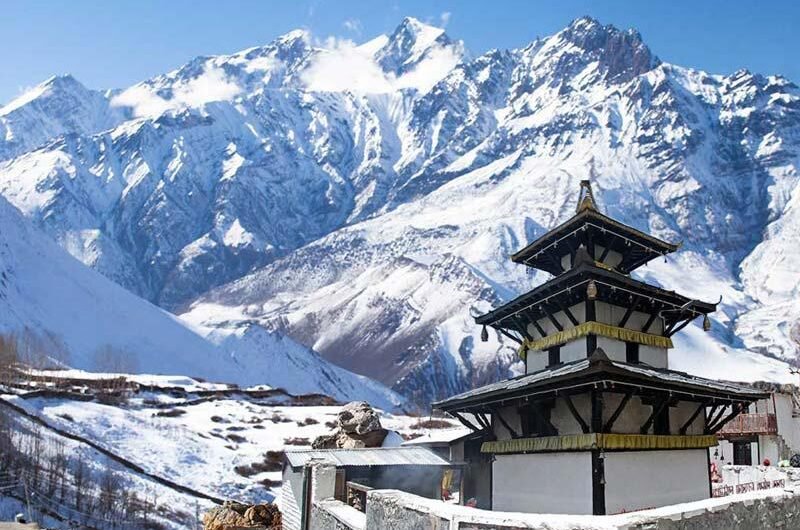Muktinath Temple is Tucked away in the breathtaking Annapurna range of Nepal, Muktinath Temple epitomizes spiritual serenity and stunning natural splendor. This revered site is a beacon for pilgrims and travelers alike, offering a unique blend of religious significance, cultural heritage, and breathtaking landscapes. In this article, we’ll delve into the rich history of Muktinath, provide a detailed itinerary for your visit, highlight the best time to go, and cover practical details such as how to reach, visa process, and nearby attractions.
History of Muktinath Temple
Muktinath, meaning “the place of liberation or moksha,” is one of the holiest sites for both Hindus and Buddhists. For Hindus, it is one of the 108 Divya Desams, or sacred Vishnu temples. Buddhists refer to it as Chumig Gyatsa, which translates to “Hundred Waters,” and consider it a place of Dakinis, goddesses known for their spiritual insight.
The temple complex is ancient, with roots tracing back to the 12th century. It is believed that Guru Rinpoche, also known as Padmasambhava, the great sage who introduced Buddhism to Tibet, meditated at Muktinath. This confluence of beliefs makes the temple a unique spiritual destination, celebrated for its capacity to unite diverse religious traditions in harmony.
Detailed Itinerary
Day 1: Arrival in Kathmandu
Morning: Arrive in Kathmandu, the capital city of Nepal.
Afternoon: Visit Pashupatinath Temple and Boudhanath Stupa to experience the spiritual aura of the city.
Evening: Explore Thamel, a bustling neighborhood known for its vibrant atmosphere and shopping.
Day 2: Kathmandu to Pokhara
Morning:
Catch an early flight or hit the road to Pokhara. The flight treats you to spectacular aerial vistas of the Himalayas.
Afternoon: Check into your hotel and relax.
Evening: Stroll around Phewa Lake and visit Tal Barahi Temple.
Day 3: Pokhara to Jomsom
Morning: Fly to Jomsom, a picturesque town in the Mustang district.
Afternoon: Acclimate to the altitude and explore the local markets.
Evening: Rest in preparation for the next day’s journey to Muktinath.
Day 4: Jomsom to Muktinath
Morning: Drive or trek to Muktinath Temple. The journey takes you through stunning landscapes and remote villages.
Afternoon: Visit the temple, take a holy bath under the 108 waterspouts, and explore the nearby Jhinu Kunda, a sacred pool.
Evening: Return to Jomsom for an overnight stay.
Day 5: Jomsom to Pokhara
Morning: Fly back to Pokhara.
Afternoon: Visit Davis Falls and Gupteshwor Cave.
Evening: Enjoy a relaxing boat ride on Phewa Lake.
Day 6: Pokhara to Kathmandu
Morning: Return to Kathmandu by flight or road.
Afternoon: Free time for shopping and exploring local markets.
Evening: Farewell dinner at a traditional Nepali restaurant.
Best Time to Visit
The ideal time to visit Muktinath Temple is during the spring (March to May) and autumn (September to November) seasons. During these periods, the weather is pleasant, skies are clear, and the trekking routes are most accessible. Winter can be very cold and snowy, making travel difficult, while the monsoon season (June to August) brings heavy rains and landslides, posing significant travel challenges.
How to Reach Muktinath Temple
By Air
To Kathmandu: International flights to Tribhuvan International Airport (KTM).
To Pokhara: Domestic flight from Kathmandu to Pokhara Airport (PKR).
To Jomsom: Short domestic flight from Pokhara to Jomsom Airport (JMO).
By Road
Kathmandu to Pokhara: Approximately 6-8 hours by bus or private vehicle.
Pokhara to Jomsom: Accessible via road, though it is a longer and more challenging route.
Trekking
For adventure enthusiasts, trekking routes are available from Jomsom to Muktinath, offering an immersive experience through rugged terrain and scenic beauty.
Visa Process
Travelers to Nepal need a visa, which can be obtained on arrival at the Tribhuvan International Airport or at land border crossings.
On Arrival Visa: Fill out the application form at the airport, provide a passport-sized photo, and pay the visa fee (15 days – $30, 30 days – $50, 90 days – $125).
eVisa: Alternatively, you can apply for a visa online through the Department of Immigration website before your trip.
Nearby Places to Visit in Muktinath
Kagbeni
A charming village near Jomsom, Kagbeni is known for its medieval architecture and as the gateway to Upper Mustang.
Marpha
Famous for its apple orchards and apple products, Marpha is a delightful stop for trekkers.
Tatopani
Renowned for its natural hot springs, Tatopani offers a relaxing respite after long treks.
Lumbini
The birthplace of Lord Buddha, Lumbini is a significant pilgrimage site with numerous monasteries and historical landmarks.
Annapurna Circuit
For trekking enthusiasts, the Annapurna Circuit offers a challenging yet rewarding experience with stunning views of the Himalayan range.
Conclusion
Muktinath Temple is more than just a pilgrimage site; it is a journey into the heart of Nepalese culture, spirituality, and natural beauty. Whether you are seeking spiritual fulfillment, adventure, or simply the serenity of the mountains, Muktinath promises an unforgettable experience. Plan your visit thoughtfully, respecting the local customs and environment, and immerse yourself in the profound tranquility that this sacred place offers.
Source Nepal Tourism Official Website —-> https://ntb.gov.np/en/muktinath–mustang.
